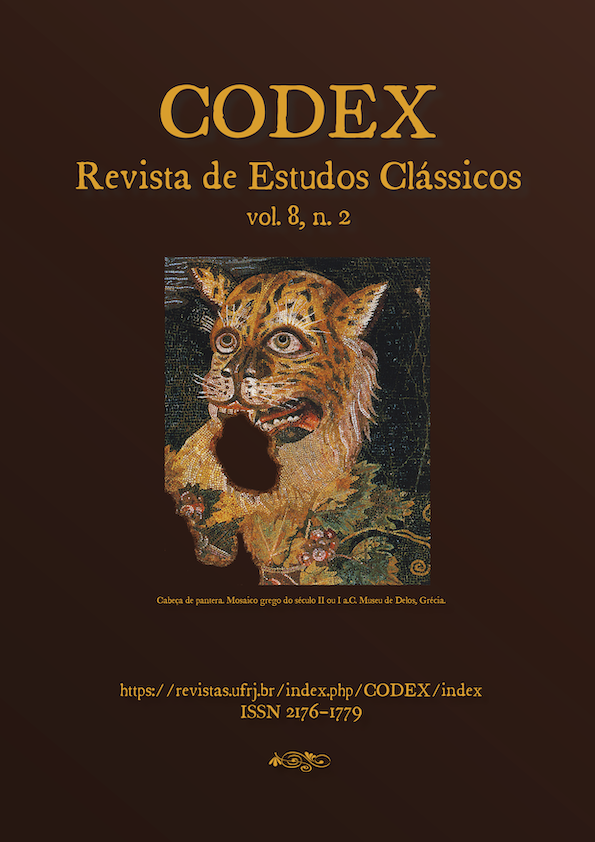As graças de Êucaris: análise e tradução poética do epigrama CLE 55
DOI :
https://doi.org/10.25187/codex.v8i2.36024Mots-clés :
epigrafia, poesia, tradução, latim, mitoRésumé
Apresentamos uma análise e tradução, inéditas em língua portuguesa, do epigrama funerário CLE 55, CIL 06, 10096, datado entre os séculos I e II a.C. e encontrado em Roma. Dedicado à liberta Êucaris Licina, o epigrama CLE 55 destaca-se pela extensão de seus versos e, principalmente, por suas reflexões e jogos metalinguísticos. Se faz, além disso, muito presente a intertextualidade que o poema traça com algumas figuras mitológicas, como, por exemplo, as Cárites, que ressoa no nome da jovem falecida Êucaris. Para a realização de nossa tradução, utilizamos o texto estabelecido por Bücheler-Lommatzsch, no Carmina Latina Epigraphica (1895), representações do texto inscrito e fotografias oferecidas pelos museus responsáveis pela preservação desses suportes. Essas informações nos permitem repensar nossa tradução, buscando reconstruir o estilo individual e recriar a poeticidade na materialidade verbal e visual desse texto.
Téléchargements
Références
BÜCHELER, F.; LOMMATZSCH, E; RIESE, A. Anthologia Latina. Inscriptiones Latinae antiquissimae ad C. Caesaris mortem. Leipzig: Teubner, 1895.
CAMPOS, H. Da tradução como criação e como crítica. In: CAMPOS, H. Metalinguagem & outras metas. São Paulo: Perspectiva, 2006, pp. 1-18.
CAMPOS, H. de. Transcriação. São Paulo: Perspectiva, 2015.
CAIRNS, F. Generic composition in Greek and Roman poetry. Edinburgh, GB: Edinburgh University Press, 1972.
CICERO. De re publica; De legibus. Trad. Clinton Walker Keyes. Cambridge, Mass.: Harvard University Press; London: W. Heinemann, 1928.
CESILA, R. T. Epigrama: Catulo e Marcial. Campinas, SP: Editora da Unicamp; Curitiba, PR: Editora da UFPR, 2017.
COURTNEY, E. Musa Lapidaria: a selection of Latin verse inscriptions. Atlanta, Georgia: Scholars Press, 1995.
DEZOTTI, J. D. O epigrama latino e sua expressão vernácula. Dissertação de mestrado. São Paulo, PPGLC-FFLCH-USP, 1990.
FARIA, E. Dicionário Latino-Português. Belo Horizonte: Livraria Garnier, 2003.
FUNARI, P. P. A. A vida quotidiana na Roma Antiga. São Paulo: Annablume, 2003.
HESÍODO. Teogonia. A origem dos deuses. Tradução e estudo de Jaa Torrano. São Paulo: Roswitha Kempf, 1991.
KEPPIE, L. Understanding Roman inscriptions. London: Batsford, 1991.
KNOX, B. Introdução. In: HOMERO. Odisseia. Trad. Frederico Lourenço. São Paulo: Penguin Classics Companhia das Letras, 2011.
LOURENÇO, F. Prefácio. In: HOMERO. Ilíada. Trad. Frederico Lourenço. São Paulo: Penguin Classics Companhia das Letras, 2013.
SAMOYAULT, T. A Intertextualidade. Tradução de Sandra Nitrini. São Paulo: Aderaldo & Rothschild, 2008.
SARAIVA, F. R. dos Santos. Novíssimo dicionário latino-português. 10a ed. Rio de Janeiro: Livraria Garnier, 1993.
TOLMAN Jr., J. A. A study of the sepulchral inscriptions in Buecheler’s “Carmina Epigraphica Latina”. Chicago, Illinois: The University of Chicago Press, 1910.
UNHEIM, S. Boderline Virginities, Sacred and Secular Virgins in Late Antiquity. Londres: Routledge, 2017.
VERANO, R.; MARTINEZ, C. F. El epitafio emeritense de iulia anulla: Un nuevo caso de doblete epigráfico. Epigraphica – Periodico Internazionale di Epigrafia, LXXIV, 1-2. Itália: Frateli Lega Editori, 2012, pp. 217-228.
Téléchargements
Fichiers supplémentaires
Publiée
Comment citer
Numéro
Rubrique
Licence
A Codex - Revista de Estudos Clássicos utiliza uma licença Creative Commons - Atribuição-NãoComercial 4.0 Internacional.
Os autores dos trabalhos aprovados autorizam a revista a, após a publicação, ceder seu conteúdo para reprodução em indexadores de conteúdo, bibliotecas virtuais e similares.
A revista se permite o uso dos trabalhos publicados para fins não comerciais, incluindo o direito de enviar o trabalho para bases de dados de acesso público.










